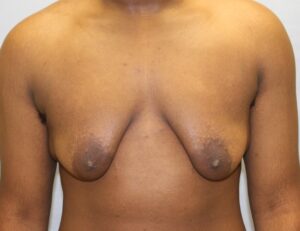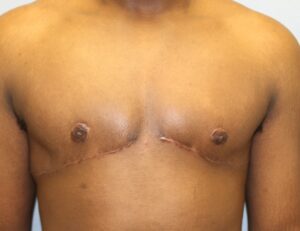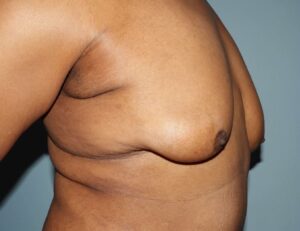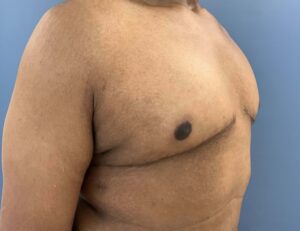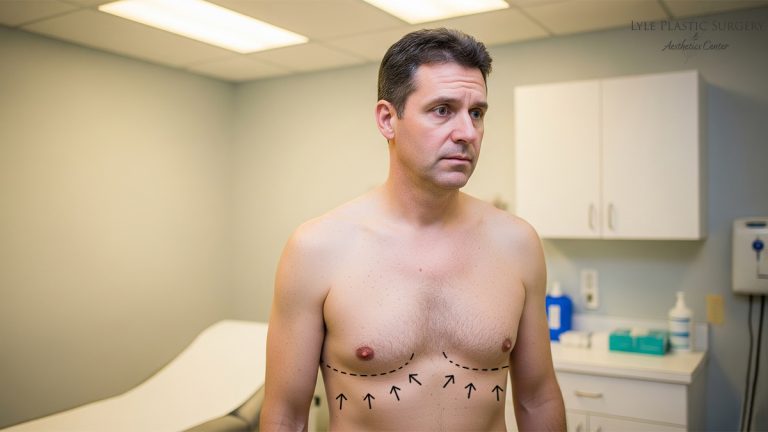
Gynecomastia – commonly referred to as “gyno” – is a condition that can have a profound impact on how men feel about themselves. The condition, defined by the enlargement of male breast tissue, may affect physical appearance in a way that undermines confidence and self-esteem. Men with gynecomastia often feel limited in what clothing they can wear comfortably, shy away from athletic or recreational activities, and may even avoid social or intimate experiences. What is important to know is that this condition is not unusual, it is not a result of poor personal choices, and it is treatable.
As a board-certified plastic surgeon in Raleigh, NC, I, Dr. Glenn Lyle, have seen firsthand how addressing gynecomastia can transform not only a patient’s chest contour but also their overall quality of life. Understanding the two main forms of gynecomastia – glandular and fatty tissue – is essential in choosing the right treatment. In my practice, I use advanced surgical techniques to help men achieve natural-looking, long-lasting results. This article will explain the two types of gynecomastia, how they are diagnosed, and what modern treatment looks like when performed with precision and artistry.
What Is Gynecomastia?
The Two Types Of Gynecomastia
Gynecomastia is the enlargement of the male breast caused by glandular overgrowth, fat accumulation, or both. It can affect men at any age and has a range of potential causes, including hormonal changes, certain medications, weight fluctuations, or even genetics. While temporary gynecomastia can occur in puberty and often resolves naturally, persistent gynecomastia in adults is usually permanent without surgical treatment. For many men, this condition is more than a cosmetic issue. It represents a barrier to living freely and comfortably, influencing how they present themselves in public and how they view themselves privately.
Men who live with gynecomastia often describe feeling self-conscious in settings where the chest is visible, such as at the pool or gym. Some report physical discomfort such as tenderness or sensitivity in the chest region. Others simply feel frustration that, despite dedicated efforts with diet and exercise, their chest does not match the rest of their physique. These feelings are valid and common, and acknowledging them is the first step toward seeking a solution. Gynecomastia surgery provides men with an opportunity to align their appearance with their lifestyle, helping them regain the confidence to live without restriction.
Glandular Gynecomastia
Glandular gynecomastia results from an overgrowth of firm glandular breast tissue. This type is most often associated with hormonal imbalance, genetic predisposition, or medication use. The tissue feels dense to the touch and does not respond to weight loss, exercise, or lifestyle changes. Patients with glandular gynecomastia usually notice that their chest maintains a fuller, more projected look regardless of how lean they are.
The treatment for glandular gynecomastia requires surgical excision. In my Raleigh practice, I perform this procedure through a discreet incision placed along the edge of the areola. This approach allows me to directly remove the glandular tissue while minimizing visible scarring. In more severe cases with excess skin, additional incisions are necessary to sculpt the chest.
My goal is not simply to remove the tissue but to carefully sculpt the chest so that it looks naturally masculine, balanced, and proportional. Patients often express immediate relief after surgery, both physically and emotionally, as they finally achieve the chest contour they have been striving for.
Fatty Tissue Gynecomastia (Pseudogynecomastia)
Fatty tissue gynecomastia, sometimes called pseudogynecomastia, occurs when the chest enlarges primarily due to fat deposits rather than glandular tissue. It is more common in men who have experienced weight gain, obesity, or age-related changes in body composition. This form of gynecomastia often results in a softer appearance that may shift with overall weight changes. Yet, for many men, the chest remains resistant to dieting and exercise, leaving them discouraged.
The treatment for fatty tissue gynecomastia is advanced liposuction. At my practice, I use both MicroAire PAL (power-assisted liposuction) and VASER-assisted liposuction to remove fat with precision. These technologies allow me to target stubborn fat, even in fibrous male chest tissue, while also providing the benefit of skin tightening. This produces smoother results and a chest contour that is more athletic and natural. Patients appreciate the relatively quick recovery and the significant improvements they see soon after surgery
Mixed Gynecomastia
Most men with gynecomastia actually present with a mixture of both glandular tissue and fatty deposits. This mixed type can create both firmness beneath the nipple and excess bulk across the chest. For these patients, neither liposuction alone nor excision alone will provide the best outcome. A hybrid approach is necessary. In these cases, I combine surgical excision of the glandular tissue with advanced liposuction techniques and frequently with Renuvion- a skin tightening device. This comprehensive method allows me to address all aspects of the condition, creating a more masculine, flatter, and better-contoured chest. Patients who undergo this combined procedure often achieve results that are both dramatic and natural, restoring not only their physical shape but their confidence as well.
Diagnosing The Type Of Gynecomastia
The success of gynecomastia surgery relies on proper diagnosis. Each patient who visits my Raleigh, NC plastic surgery practice receives a detailed consultation and evaluation. This begins with a thorough review of medical history, lifestyle, and any possible contributing factors such as medications or family background. During the physical exam, I assess the texture and distribution of the chest tissue, determining whether it is primarily glandular, fatty, or mixed. Mammography is rarely used unless there is a concern about a possible breast cancer- which can occur in men. However, mammography sometimes can determine the extent of fatty infiltration.
By identifying the specific type of gynecomastia, we can tailor a treatment plan that addresses the underlying cause, ensuring that the results are long-lasting and satisfying. The diagnostic process is also an important step in building trust, as it reassures patients that their concerns are being carefully evaluated and respected.
Surgical Techniques Tailored To You
Every man’s chest is unique, and the surgical plan must reflect that individuality. For patients with glandular gynecomastia, the surgical technique involves making a careful incision around the areola and directly removing the glandular tissue. My approach emphasizes precision and artistry, with the goal of leaving the chest flat, defined, and natural in appearance. The incision placement is discreet, and scarring is minimized to ensure results that are both visible and subtle.
For patients with fatty tissue gynecomastia, liposuction provides the best results. I use advanced devices such as MicroAire PAL and VASER to break down and remove fat efficiently. These methods are especially effective in treating the dense, fibrous fat that often characterizes the male chest. The use of this technology also enhances skin retraction, giving the chest a smooth and natural contour. Patients are often surprised by how quickly they recover and how soon they see improvements in their chest shape.
In cases of mixed gynecomastia, I employ a hybrid approach that combines glandular excision with liposuction. This technique allows me to fully address both the firmness of glandular tissue and the bulkiness of excess fat. The result is a chest that looks balanced and natural, free from the protrusion and fullness that once caused discomfort and self-consciousness. Many men describe the transformation as life-changing, giving them the freedom to feel at ease in their clothing, at the gym, or in personal relationships.
Recovery And Results
Recovery from gynecomastia surgery is typically straightforward and manageable. Most men find the process easier than they expected. Immediately after surgery, patients notice a visible improvement in chest shape. Swelling is normal during the initial healing phase, but even with swelling, the chest already appears flatter and more masculine.
Most men return to work or light activities within five to seven days. A compression garment is worn during recovery to help reduce swelling and support the new chest contour. By the two-week mark, light cardio activity can usually be resumed, while more strenuous exercise, including weight training, is typically safe after four to six weeks. By three months, most of the swelling has subsided, and the final results become clear.
Patients often describe a renewed sense of confidence after surgery. They are able to wear fitted shirts, participate in physical activities without hesitation, and feel more at ease in social and intimate settings. The impact goes beyond physical appearance, touching every aspect of life and restoring the self-assurance that may have been lost to gynecomastia.

Meet Dr. Glenn Lyle
Board Certified Plastic Surgeon
Dr. Glenn Lyle, a board-certified plastic surgeon, has been proudly serving the Raleigh, NC, community at Lyle Plastic Surgery and Aesthetics Center since 2002. With a deep passion for helping patients reclaim their confidence, Dr. Lyle specializes in transformative breast surgery and body contouring procedures. Whether addressing the effects of weight loss, pregnancy, or aging, his expert care and artistic approach empower individuals to look and feel their best. Dr. Lyle is dedicated to creating beautiful, natural results that reflect each patient’s personal journey and goals.
Why Choose Dr. Glenn Lyle In Raleigh, NC?
Choosing a surgeon for gynecomastia treatment is a significant decision, and patients in North Carolina trust my practice for several reasons. As a board-certified plastic surgeon, I bring decades of surgical experience and specialized expertise in body contouring procedures. My focus is not only on removing tissue but on sculpting a natural, proportionate chest that enhances the overall physique.
At my Raleigh practice, I incorporate advanced technology, including VASER, MicroAire PAL, and often Renuvion. This commitment to advanced methods reflects my philosophy of combining cutting-edge techniques with careful, conservative decision-making for the safest and most effective outcomes.
What sets my practice apart is a patient-first philosophy. Every man I treat is unique, with his own goals, concerns, and expectations. My role is to listen carefully, provide clear information, and develop a plan that aligns with his needs. By emphasizing natural, long-lasting results, I ensure that patients leave not only with a flatter chest but also with renewed self-confidence. Serving Raleigh,Cary, Apex, Durham,Wake Forest and the broader North Carolina community, my practice is known for combining technical excellence with personalized care.
FAQs About Gynecomastia Surgery
What if my chest feels different on each side?
It is common for gynecomastia to be asymmetrical, with one side appearing larger or firmer than the other. During surgery, I carefully address both sides to create balance and symmetry. This tailored approach ensures your chest looks proportionate after healing.
Can gynecomastia come back after surgery?
Recurrence is uncommon, especially when both glandular tissue and fat are properly treated. However, significant hormonal changes, medication use, or major weight gain could influence future chest contour. With careful planning, long-lasting results are the goal.
Will the scars be obvious?
Scars are placed discreetly around the edge of the areola or in tiny access points for liposuction. Over time, most patients notice the scars fade significantly. With proper care, scars become nearly unnoticeable. When major skin reduction is needed, incisions are more extensive.
Does gynecomastia surgery change nipple sensitivity?
Some patients experience temporary changes in nipple sensation following surgery. Sensation often improves over several months as the body heals. Permanent changes are less common but can occur in rare cases. In severe cases that require major skin reduction, free nipple grafts May be necessary and in these instances, sensation is compromised.
Is there a best age to have surgery?
Gynecomastia surgery can be performed safely at almost any adult age. For younger men, it is important to ensure the condition is not temporary from puberty. For older men, the procedure can still deliver excellent results as long as they are healthy candidates.
What happens if there is loose skin after surgery?
Skin elasticity plays an important role in the final result. For most men, the skin retracts naturally after tissue removal. In cases where there is significant loose skin, additional tightening procedures may be discussed. Often, this requires excisional skin reduction which results in scars. Every attempt to make them less noticeable is made but extensive excess skin removal will lead to incisions which means scarring.
Can I combine gynecomastia surgery with other procedures?
Yes, many men choose to combine chest contouring with other body procedures such as liposuction of the abdomen or flanks. A comprehensive approach can create a balanced, athletic appearance tailored to your goals.
Medical References
- Gynecomastia: Etiology, Diagnosis, and Treatment – Endotext – NCBI
https://www.ncbi.nlm.nih.gov/books/NBK279105/ - Gynecomastia – StatPearls – NCBI Bookshelf
https://www.ncbi.nlm.nih.gov/books/NBK430812/ - Diagnostic And Surgical Approach To Gynecomastia (PDF) – Zagazig University Medical Journal
https://zumj.journals.ekb.eg/article_322456_bbee6e6645945b67319822abacba396d.pdf - Enlarged breasts in men (gynecomastia) – Diagnosis and treatment – Mayo Clinic
https://www.mayoclinic.org/diseases-conditions/gynecomastia/diagnosis-treatment/drc-20351799 - Gynecomastia: A systematic review of pharmacological treatments – Frontiers in Pediatrics
https://www.frontiersin.org/journals/pediatrics/articles/10.3389/fped.2022.978311/full - Gynecomastia: Practice Essentials, Background, Etiology – Medscape
https://emedicine.medscape.com/article/120858-overview - EAA clinical practice guidelines—gynecomastia evaluation and management – Andrology Journal
https://onlinelibrary.wiley.com/doi/10.1111/andr.12636
Final Thoughts & Call To Action
Gynecomastia is a common condition, but for many men, it feels isolating and difficult to talk about. Understanding the difference between glandular gynecomastia and fatty tissue gynecomastia is the key to identifying the best treatment. Whether the issue is firm glandular tissue, excess fat, or a combination of both, modern surgical techniques offer safe and effective solutions.
As a trusted plastic surgeon in Raleigh, NC, I, Dr. Glenn Lyle, am dedicated to helping men reclaim their confidence through personalized gynecomastia surgery. My expertise, advanced technologies, and patient-centered approach ensure that every treatment plan is designed for lasting, natural results.
You do not have to live with the discomfort and self-consciousness caused by gynecomastia. Take the first step toward a more confident, empowered version of yourself. Schedule your private consultation today or call 919-307-8585 and learn how my specialized expertise can help you achieve the masculine chest contour you have always wanted.
Further Reading
- Read Dr Lyle’s Gynecomastia
- View Dr Lyle’s Gynecomastia Gallery
- Read Dr Lyle’s Blog on Solutions for a Male Sagging Chest
